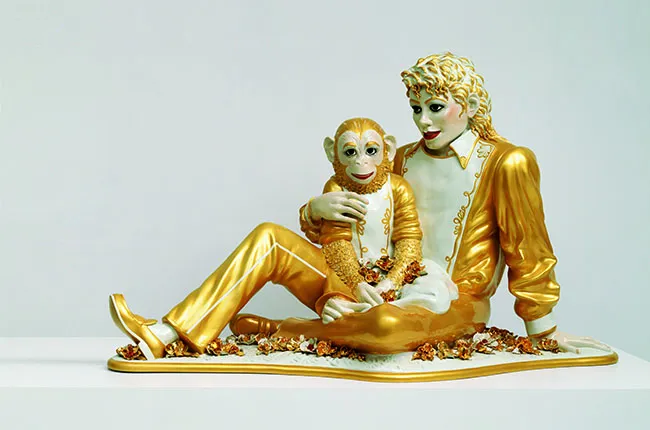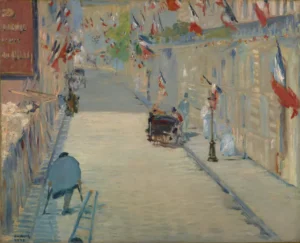Few contemporary artworks encapsulate the collision of celebrity culture and fine art as strikingly as Michael Jackson and Bubbles by Jeff Koons. Created in 1988 as part of Koons’ now-iconic “Banality” series, this porcelain sculpture immortalizes pop icon Michael Jackson alongside his beloved pet chimpanzee, Bubbles, transforming a seemingly tabloid-friendly moment into an eternal commentary on fame, artifice, and idol worship.
A Mirror to Banality
At its core, Michael Jackson and Bubbles serves as a reflective object — not merely of Michael Jackson’s public persona but of the audience itself. By crafting the piece in gleaming white porcelain with lavish gold accents, Koons elevates the subjects to a near-divine realm, echoing religious iconography typically reserved for saints and holy figures. The pose — Jackson and Bubbles gazing outward serenely, Jackson’s protective arm around his pet — recalls Renaissance Madonna and Child compositions. This deliberate parallel exposes the ways in which modern celebrity functions as a new secular religion.
The “Banality” series, to which this work belongs, was Koons’ challenge to the hierarchies of taste and aesthetic value. By appropriating objects and figures from popular culture and mass-produced kitsch, Koons effectively eroded the line between high and low art. In this sculpture, the porcelain medium — traditionally associated with decorative collectibles and sentimental figurines — amplifies the work’s kitsch quality while simultaneously demanding reverence.
Material and Craftsmanship
Executed in porcelain, the sculpture required the technical expertise of skilled craftsmen in Germany, merging industrial technique with artisanal precision. The hyper-glossy finish and immaculate detail highlight Koons’ dedication to perfection, echoing the highly controlled image that Michael Jackson himself cultivated.
The use of gold leaf on the costumes underscores themes of opulence and divine status, a comment on how celebrity transforms mere humans into gilded idols. In Jackson’s case, his meticulously curated public image and eccentric lifestyle choices made him both a muse and a mirror for mass cultural desires and anxieties.
The Symbolism of Bubbles
The inclusion of Bubbles, Jackson’s real-life pet chimpanzee, adds another layer of meaning. Bubbles symbolized Jackson’s eternal childlike persona — the “Peter Pan” mythos that Jackson often embraced. In the sculpture, Bubbles is depicted almost as an extension of Jackson himself, sharing the same delicate detailing and golden costume accents.
Through this pairing, Koons suggests a blurring of human and animal, celebrity and pet, public and private. It’s both an affectionate nod to Jackson’s idiosyncratic world and a chilling reminder of the isolating bubble that fame can create.
Reception and Critique
Upon its debut, Michael Jackson and Bubbles provoked polarized reactions. Critics accused Koons of vulgar sensationalism and blatant commercial pandering. Admirers, however, celebrated his subversive genius, lauding his fearless embrace of kitsch and his ability to probe the nature of celebrity worship.
Over time, the sculpture has come to symbolize the excesses of 1980s culture — a decade marked by hyper-consumerism, celebrity obsession, and an aesthetic love affair with the artificial. In many ways, it prefigured the even more omnipresent celebrity-fan dynamic of the digital age.
The work’s auction history further underscores its cultural weight. In 2001, one edition sold at Sotheby’s for over $5 million, underscoring how Koons’ critique of commercialization paradoxically participates in the same system it questions.
Legacy and Influence
Michael Jackson and Bubbles remains one of the most iconic pieces in Koons’ oeuvre, capturing the zeitgeist of an era while questioning its values. It paved the way for contemporary artists who grapple with themes of fame and mass media — from Takashi Murakami’s “superflat” celebrities to Yayoi Kusama’s mirrored infinity rooms designed for viral selfies.
For Koons, the sculpture also marked a turning point. It solidified his reputation as an artist unafraid to confront — and embrace — the commercial aspects of art-making. His later works, including balloon animals and stainless-steel reproductions of kitsch objects, continue to explore this tension between spectacle and sincerity.
Michael Jackson: The Idol Reconsidered
In the years since the sculpture’s creation, Michael Jackson’s legacy has become even more complex, shaped by ongoing controversies and posthumous reappraisals. In this context, Koons’ piece takes on new resonances. The golden, frozen likeness becomes a poignant relic of a man whose life was a public spectacle, a tragic figure enshrined in pop culture mythology.
It invites viewers to grapple with their own complicity in celebrity culture: our simultaneous adoration and consumption of icons, often at the cost of their humanity. The work stands as a cautionary monument to fame’s isolating glow — beautiful, immaculate, but ultimately cold and untouchable.
Impression
Jeff Koons’ Michael Jackson and Bubbles transcends its immediate shock value to become an enduring exploration of fame, artifice, and cultural longing. It challenges us to reconsider what — and who — we idolize, and to reflect on the power of art to hold up a mirror to society’s collective fantasies and fears.
Today, it remains one of the most compelling contemporary sculptures, admired and critiqued in equal measure. Whether you see it as a satire of celebrity culture, a heartfelt homage, or a cynical commentary on consumerism, one thing is undeniable: it demands to be seen, questioned, and remembered.
No comments yet.








